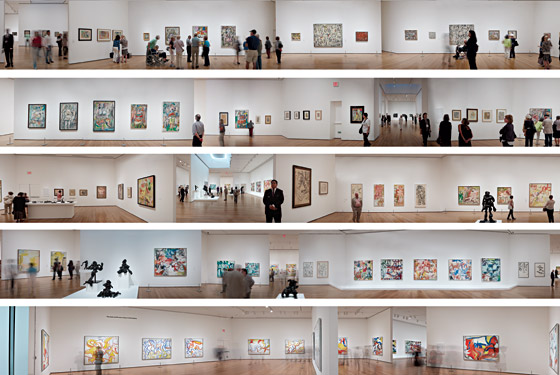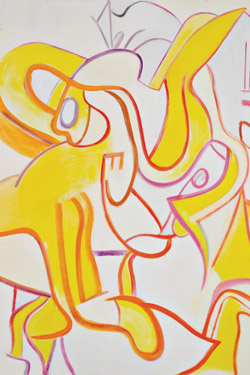
‘De Kooning: A Retrospective,” at the Museum of Modern Art, is the most piercing, inexhaustible, and relentlessly intense full-on career survey I have ever seen in this country. It could only be better by being bigger. Packing the museum’s entire sixth floor with nearly 200 paintings, prints, sculptures, and drawings (these last the equals of Ingres, Seurat, and Picasso), this retrospective should permanently set the art-historical record straight on this artist.
Willem de Kooning is generally credited for coming out of the painterly gates strong in the forties, revolutionizing art and abstraction and reaching incredible heights by the early fifties, and then tailing off. His work of the late fifties and sixties is maligned as facile or turgid, his sixties sculpture called kitsch, his abstract-figurative hallucinations of the seventies essentially ignored, his profound paintings of the eighties suspect. This show, organized by MoMA’s chief curator emeritus of painting and sculpture, John Elderfield, proves that de Kooning started great and only got better.
The opening gambit in this argument comes at the entrance, where two canvases set up a harrowing spatial-painterly struggle that plays out in all of the galleries to follow. On the left is Seated Figure (Classical Male), from 1941–43, a stiff, stately, half-headed naked man with no genitals, or maybe a large red cloth as phallus, and his right leg disconnected from his body. Even his shadow seems to be breaking away from him. Beyond triggering castration anxieties or latent authority issues, this painting suggests how terrifying it must have been for de Kooning to use—and then give up—his considerable academic skills. (A nearby still life, made when he was all of 12, shows incredible representational talent.) Even in the early forties, you see de Kooning trying to take apart and flatten Cubism, keeping the figure but also integrating it into something closer to abstraction. The image is a fuchsia-and-burnt-sienna crumbling Ingres portrait, filled with grandeur but frantic in its attempts at breaking spatial planes, courting Classicism, and coaxing modernity. Next to this is Woman Sitting (1943–44), a startling crazy-eyed figure out of Picasso by way of Matisse, Miró, Stuart Davis, Gorky, and a slipping shoulder strap of Sargent, all imbued with visual schizophrenia. She’s clothed. One breast is cantaloupe-shaped; the other, a lemon, shows a glimpse of a large pink nipple. Her oval head is slightly shifted off her torso and the chair, which feels alive and bubbles out into perspectival space. It’s a total visual-spatial war. (Edwin Denby, the critic, claimed that the artist’s struggle with perspective actually made de Kooning sick to his stomach.)
Only two paintings into the show, we’re already seeing elements of almost every work on hand: figures, fiends, demons, eunuchs, and gargoyles; arcing curves, bowing limbs, windows and doorways in the background to let you in or out; metamorphosing form, uncanny furniture, oscillating geometry, unexpected color combinations, and inchoate spatial constellations that continuously set the graphic fields into visual motion, creating unfixed coordinates that alter before your eyes into subtle structures not quite stable or seen before. From this point on, don’t think that anything you see is either purely abstract or strictly figurative.
For proof of de Kooning’s whole-ball-of-wax approach, I recommend—after you’ve been staggered by the 1950 masterpiece Excavation, a tightly constructed cave-painting supernova of jigsaw space, mouths, and pent-up-ness—spending a day or so in the visual Gatling gun that is section four of the show. It houses nineteen magnificent paintings and drawings of women, made mostly between 1950 and 1953. Start with Woman I, long a key piece of MoMA’s permanent collection. See it splinter and torque, its voluptuous, tortured half-beast turning into an avenging angel. The figure and ground merge and transform into a garish clownishness you’ve never seen before, a space that is strange, familiar, and credible. Glean how all this is subtly held together by drawing. The figure and the painting become a state of mind, windows onto other kinds of consciousness. Just as you’ve reconciled yourself to this paradoxical state of ugly beauty and beautiful ugliness, and this new kind of human being or monster of the id, in Woman II de Kooning simultaneously lays waste to and consolidates this new ugliness into something sketchier, less familiar, and more lit up. Then, in Woman III, the color reduction, structured abstraction, and multiplying interstitial space of the forties are integrated into the new figurative pictorial field. There’s even that same image of a window, echoed from those first two paintings. By the time he gets to Woman VI, from 1953, his ball of wax has exploded, and we’re in an entirely new world.
De Kooning’s both-not-one-or-another position allowed him to engage visionary visual tools to imagine and decipher the universe. Yet at the time this cost him dearly. Clement Greenberg called keeping the figure in his art a major mistake and claimed de Kooning was in decline. Robert Hughes lambasted his art as “self-parody.” Jackson Pollock, whom de Kooning always spoke of admiringly, railed, “Bill, you betrayed it. You’re doing the figure. You’re still doing the same goddamned thing.” At the same moment, the young, gifted Robert Rauschenberg showed up at his studio door, asked for and received one of de Kooning’s drawings, and erased it.

That was in the mid-fifties, as de Kooning was being pretty nearly written off, assumed to be regressive by an art world that was pronouncing painting dead. At MoMA, we see him continuing at the same accelerated growth rate as before, circling back, striking out, destroying work, starting over, always pushing himself. After the Women, there’s work here from the late fifties, paintings that I too had always written off as murky. Now I see that de Kooning kept painting the women—just leaving the women out. In paintings like Easter Monday, Merritt Parkway, Bolton Landing, and Rosy-Fingered Dawn at Louse Point, made between 1955 and 1963, he takes his vision into the sunlight, enlarging his scale and brushstrokes, going with less drawing, letting more light into spaces he’d always depicted. I was stunned here. As I was with those luscious so-called abstractions from the seventies, paintings I have loved unabashedly, despite their bad rap, for decades. Even here, in these profuse oceanic fields that resonate with Turner-like amorphousness and luminous energy, are boneless body parts, hints of reclining figures, the windows and doorways of the earlier work, wet-on-wet sensuousness. You look at these teeming paintings and know that they’re made out of the same thing we’re made out of. As de Kooning put it, “Flesh is the reason oil paint was invented.”
In the final gallery comes the wintry incandescence of the last works, and they take my breath away. Exquisitely lyrical looping locutions, lone lines of coral-reef color, umbilical curves: They curl and cut back in viscous fields of mysterious expanding space. The widows and chairs of the first paintings are here. As is the space, so hard won. In this gallery is his last rite of visual passage, the perfectly titled The Cat’s Meow—centrifugal harmonies in pastel that let you see the order and ecstasy in chaos, and the chaos in order and ecstasy. (Some of the paintings from this period are tainted by whispers: that de Kooning was being heavily aided by his assistants, that his developing dementia was robbing him of intellect. I see an artist fully in control.)
Everything on hand makes it impossible to think that by 1959 de Kooning was repeating himself, betraying causes, making cotton-candy abstractions, turning out second-rate sculpture, or running on painterly fumes. It should also make all those curators who consider painting moribund and regressive, rarely including it in their shows, see the idiocy of their ways. I challenge any of them to name one thing wrong with any work on view here. What we see, from beginning to end, is a cosmos unto itself, visual wisdom for the ages.
de Kooning:A Retrospective
Museum of Modern Art.
Through January 9, 2012.
E-mail: jerry_saltz@newyorkmag.com.